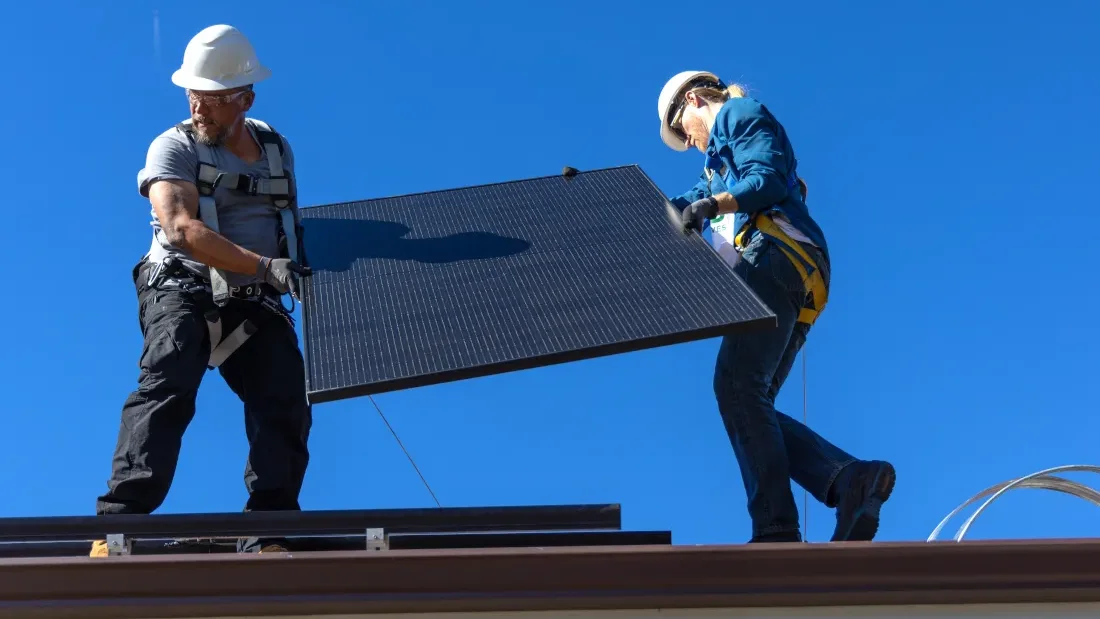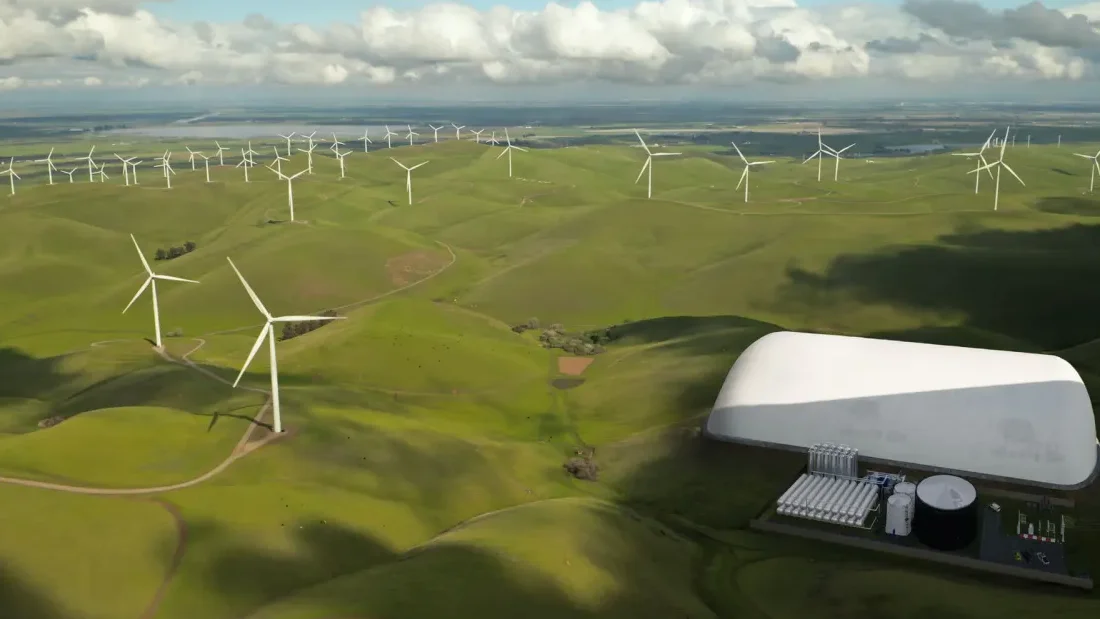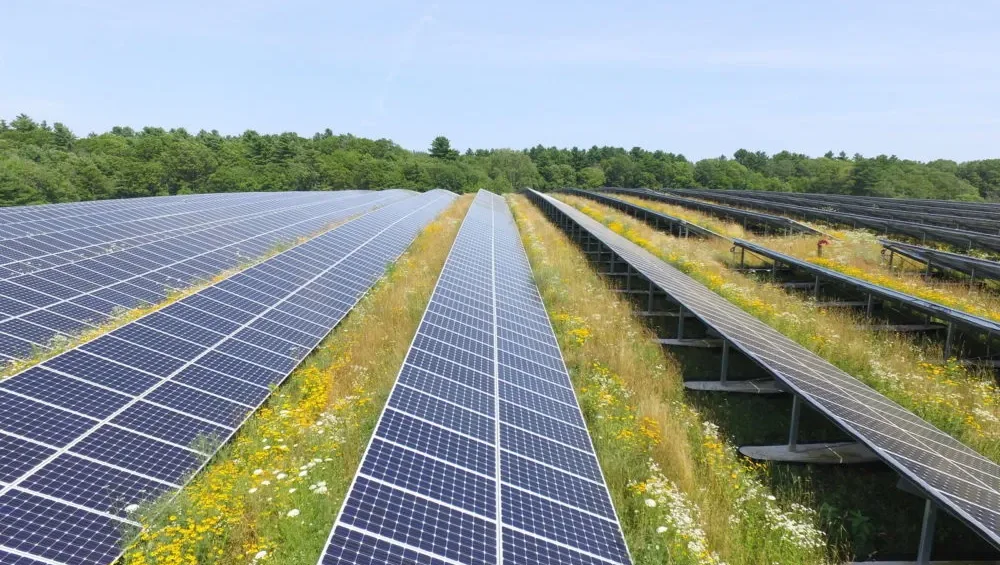
BUILDINGS: Maine receives a $10 million federal grant to install specially designed heat pumps in mobile homes, with a specific focus on small towns. (Maine Public)
GRID:
OVERSIGHT: New York Gov. Kathy Hochul appoints a former state commissioner and an environmental advocate to fill two open seats on the state’s Public Service Commission. (E&E News, subscription)
UTILITIES: Maine lawmakers discuss a bill that would allow state regulators to use utilities’ performance as a basis for ratemaking. (Portland Press Herald)
SOLAR:
TRANSPORTATION: New Jersey Gov. Phil Murphy proposes a tax on large corporations to fund mass transit. (Daily Record)
ELECTRIC VEHICLES:
HYDROGEN:
CARBON CAPTURE: New York lawmakers advance a bill that would ban the use of carbon dioxide injection to extract natural gas, in response to a developer’s plan for the state’s Southern Tier. (Waterfront Online)
GEOTHERMAL: Bard College in upstate New York plans a new geothermal system to provide heating and cooling to the campus library. (ThinkGeoEnergy)

CLEAN ENERGY: The Biden administration allocates $366 million for clean energy development on tribal land and rural areas, including solar and hydropower projects in Washington, Alaska and Arizona. (Associated Press, Anchorage Daily News, Arizona Republic)
ALSO: The U.S. Energy Department seeks clean energy development proposals at its WIPP nuclear waste disposal facility in southern New Mexico. (news release)
SOLAR:
UTILITIES:
OIL & GAS: Data show states hold 1.6 million acres of land within tribal nations, some of which is leased for oil and gas drilling. (High Country News)
DIVESTMENT: Oregon lawmakers near a final vote on a bill that would divest the state’s public employee retirement system from coal-related stocks. (Oregon Capital Chronicle)
ELECTRIFICATION: A California city replaces its natural gas hookup ban with efficiency standards encouraging the use of electric heat pumps and water heaters. (Palo Alto Online)
GRID: NV Energy tells regulators its proposed Greenlink transmission project in Nevada is $433 million over budget, a cost likely to be borne by ratepayers. (Las Vegas Review-Journal)
CLIMATE:
POLITICS: Far-right Wyoming lawmakers look to defund an energy grant program that has supported carbon capture and sequestration and hydrogen production research in the past. (WyoFile)
COMMENTARY: A California columnist argues a slowdown in electric vehicle sales is less concerning than America’s apparent inability to transition away from its car-centric culture. (Los Angeles Times)

SOLAR: A clean energy group’s analysis finds a $7 billion federal program is on track to help more than 700,000 lower-income households install solar and storage systems, making it the largest such investment in U.S. history. (Canary Media)
ALSO: A Cornell University researcher studies what types of crops can best co-exist with solar panels on New York farms. (Spectrum News)
HYDROGEN: The U.S. Energy Department reportedly wants the Treasury to relax its guidance for clean hydrogen incentives, saying the strict rules threaten the industry’s expansion. (E&E News)
CLIMATE:
CLEAN ENERGY: A new report estimates a worker shortage of 1.1 million people across 20 occupations that are crucial for rolling out the Biden administration’s clean energy agenda. (E&E News, subscription)
STORAGE: At least 30 startups look to store renewable power by heating up rocks and other materials, hoping thermal storage can solve solar and wind’s intermittency challenges. (Canary Media)
GRID:
OIL & GAS:
GEOTHERMAL: Oil and gas companies are ramping up investments in geothermal power, betting that drilling for underground heat could be their key into the clean energy industry. (Wall Street Journal, subscription)
ELECTRIC VEHICLES: Ford electric vehicle owners can now use Tesla public chargers, but they first must get a free adapter from Ford. (ABC News)
NUCLEAR: The U.S. House advances a bill to speed environmental reviews for new nuclear reactors, which it will have to reconcile with the Senate’s nuclear legislation. (The Hill)

UTILITIES: The FirstEnergy scandal unfolding in Ohio is part of a resurgence of fraud and corruption in the U.S. utility sector that come as those companies aim to spend billions of dollars in clean energy initiatives. (Floodlight/Mother Jones)
ALSO:
PIPELINES:
SOLAR: A pollinator scorecard developed at Michigan State University helps solar developers mitigate the effects of utility-scale projects when applying for permits. (Interlochen Public Radio)
POLLUTION: Newly proposed legislation in Minnesota would require stronger testing at polluting facilities, and increase penalties for violations, in environmental justice areas. (Sahan Journal)
GRID: Minnesota is among states across the country considering legislation on grid-enhancing technologies that maximize current transmission and increases renewable energy capacity. (E&E News)
RENEWABLES: A northeastern Ohio county plans to take action soon on requests from multiple townships to ban utility-scale wind and solar development. (WKBN)
BIOGAS:
COMMENTARY: Minnesota clean energy and environmental advocates say state lawmakers can help cut emissions from two major sectors — agriculture and transportation — with a proposed clean transportation standard. (MinnPost)

COAL: Utah lawmakers pass a bill that would allow the state to purchase a coal power plant slated to transition to natural gas and hydrogen production in coming years. (Deseret News)
OIL & GAS:
WIND:
SOLAR:
UTILITIES:
ELECTRIC VEHICLES: A company shuts down its 425-employee electric bus manufacturing facility in southern California, citing supply chain constraints and rising costs. (Mercury News)
TRANSPORTATION: The Biden administration awards Colorado $84 million to support public transit. (KDVR)
CLIMATE:
NUCLEAR: The U.S. House passes a bill that would streamline advanced nuclear reactor permitting and support developers in overcoming regulatory hurdles. (Deseret News)
HYDROGEN: Chevron plans to develop a 5 MW solar-powered hydrogen production facility in California’s Central Valley. (Solar Industry Magazine)

⛷️ Good morning! Kathryn is just back from a much-deserved vacation and will return to the Weekly next week.
Meanwhile, gather ’round! We need to talk about hydrogen.
In theory, hydrogen sounds like a miracle fuel. Split water molecules with clean power, use the hydrogen to fuel everything from trucks to steelmaking, boom: endless clean energy. Doesn’t that sound nice?
Reality, of course, is never that simple, and with all the news about hydrogen hubs and the rainbow of green vs. blue vs. pink and so on, it’s easy to get lost.
But if you only have the bandwidth for one hydrogen story right now, it should be the debate over a tax credit called 45V, that could have major implications for future emissions.
As reporter Kari Lydersen explained in a story earlier this month, draft rules for the 45V tax credit require “green” hydrogen to be produced by new, adjacent renewable energy to qualify, much like the illustration above.
But promoters of hydrogen hubs, which energy writer David Roberts has dismissively dubbed “subsidy-farming machines,” sent a letter Monday urging the Treasury Department to allow green hydrogen produced from existing renewable energy to qualify, arguing the proposed rules are so strict they’ll be unable to bring productions costs down quickly enough to meet federal goals.
Earthjustice attorney Lauren Piette calls that a “loophole” that will simply divert existing clean energy capacity that would then be backfilled by coal and gas generation, potentially causing a net increase in emissions and spiking utility bills.
Beyond grid implications, advocates are also warning of other unintended climate consequences if hydrogen is not used or handled carefully — potentially creating more heat-trapping emissions than burning natural gas.
🚘 Something we can agree on: While policies to phase out gasoline cars have become politically polarized, a study finds electric vehicles are popular with Democrats and Republicans alike. (CNN)
🌊 A milestone for offshore wind: Vineyard Wind last week became the first large-scale offshore wind farm in the U.S. to begin delivering power, a step Massachusetts Gov. Maura Healey calls “a turning point in the clean energy transition.” (Associated Press)
🏡 Building tension: Policies to improve energy efficiency in housing have faced strong opposition from builders associations, who frequently deploy inflated cost estimates to fight code upgrades. (Washington Post)
✅ Just in case: Federal regulators are scrambling to implement policies to cut heat-trapping emissions and meet U.S. climate obligations in case the White House changes hands after the 2024 election. (Bloomberg)
💡 Looking to the future: State and local governments are preparing applications for a $5 billion federal grant program to implement big ideas in climate action plans. (Energy News Network)
🏢 Greener cities: A Chicago environmental justice organization is helping to build out a geothermal heating and cooling network on the city’s South Side. (Grist)
👷 Learning from history: A new weatherization jobs resource hub in Wisconsin is part of advocates’ effort to avoid the boom-and-bust cycle that followed previous increases in federal energy efficiency funding. (Energy News Network)

Climate advocates, public officials, and the solar industry are asking Massachusetts to update its solar incentive program to reignite slowing growth in the sector while making the system fairer and more effective.
The Solar Massachusetts Renewable Target (SMART) program hit its fifth anniversary in late 2023, and the state has launched a review to determine how to adapt the system to current economic realities and environmental priorities. While most agree it has been an effective system for supporting the growth of solar, stakeholders would also like to see changes that would better respond to fluctuating market conditions and encourage development on the most suitable sites.
These recommendations come at a time when the Massachusetts solar industry is losing some momentum, despite the incentives the state provides. The state’s clean energy and climate plan estimates Massachusetts will need some 27 gigawatts of solar capacity by 2050 to meet the goal of going carbon neutral by that year. But current development is not keeping pace. In 2021, the state’s new solar installations topped 600 megawatts, according to data from the Solar Energy Industries Association. In 2022 and 2023, installations dropped to roughly half that level.
“SMART has done a good job of continuing the deployment of solar in the commonwealth and there are a number of really good components to it,” said Mark Sylvia, chief of staff at Blue Wave Solar. “Now we’re at an important inflection point.”
SMART works by paying the owners of solar installations a set rate per kilowatt-hour of power they produce. The base rate is determined by the project’s size and location; so-called “adders” increase the rate for projects that serve low-income households, are located on rooftops, or have other features the state wants to encourage. The system was designed on the assumption that the cost of building solar would keep dropping as demand grew, reducing the need for subsidies. Thus, SMART rates get lower as more solar capacity is built.
Many stakeholders have raised concerns about continuing this declining rate model. In recent years, costs have not continued falling as expected. Instead, supply chain problems during the COVID pandemic and changes to steel tariffs drove up equipment prices. Costs to interconnect to the grid and to acquire land for solar developments have risen as well.
Industry players and environmental advocates have suggested replacing the declining rate approach with a mechanism that would adjust rates according to market conditions once or twice a year.
“There’s this across-the-board issue around SMART rates being lower than they need to be to drive the market,” said Nick D’Arbeloff, president of the Solar Energy Business Association of New England. “SMART as a whole has to rethink how it can better incent projects.”
Additional rate adjustments could also be used to push specific policy priorities more effectively, said many.
Several pointed to the issue of solar canopies, panels mounted high enough above the ground to provide shade and shelter from rain, usually in parking lots. A report released by the state in July found that the state’s parking lots had the technical potential to support some 14 gigawatts of capacity on solar canopies. However, material and equipment costs make building canopies particularly pricey right now.
SMART already includes an adder for canopies of 6 cents per kilowatt-hour, but it isn’t enough to cover the additional costs. Strategically increasing the adder would make canopies more financially feasible and could help capture some of the untapped potential parking lots offer, supporters said.
Tweaks to the program could also help more low-income households realize the financial and environmental advantages of solar power, said Ben Underwood, co-chief executive and co-founder of Resonant Energy, a Boston-based solar development company focused on projects that benefit low-income communities.
The program currently incentivizes these developments in a few ways. It offers adders for projects on low-income properties and for community solar facilities that allocate more than half of their production to low-income customers, and provides higher base rates for projects smaller than 25 kilowatts on low-income households.
However, these nudges have had little effect so far. Just 4% of the small systems using SMART qualify for the low-income base rate, though Underwood estimates roughly one-third of Massachusetts households could qualify.
“The rates are not leading to adoption in a way that’s proportionate,” he said.
To jumpstart more development in this sector, Underwood would like to see the compensation rates for low-income projects returned to at least their original starting points — between 35 cents and 39 cents per kilowatt-hour, depending on utility — and be exempted from decreases over time.
“There’s really not a risk of having deployment be too fast at this point, so long as sufficient consumer protections are in place, because there’s so much ground that needs to be made up,” he said.
As interest in solar has expanded, siting has been an ongoing controversy in Massachusetts. Some advocates object to the use of previously undeveloped lands for solar projects, arguing that cutting down trees and disturbing habitats for the sake of renewable energy does more harm than good. Others contend that the state’s ambitious solar goals can’t be reached without using at least some so-called “greenfields.”
“It is the industry’s belief that we’re going to have a very hard time reaching the goals Massachusetts has set for itself if we suddenly cease using available land for solar,” D’Arbeloff said.
Many commenters have suggested there are ways to bridge this divide.
The current rules subtract a fraction of a cent per kilowatt-hour from the compensation rate for projects on greenfield land. However, the state should also consider looking more carefully at the parcels included in this definition, said Jessica Robertson, director of policy and business development for New England at solar developer New Leaf Energy.
Now, a large parcel might be subject to the lower rate even though only a small portion of the land within it is considered unsuitable for development. In other cases the data used to classify the land is very out-of-date. Robertson pointed to one case in which a piece of land occupied by a gravel pit was classified as agricultural using soil samples from decades prior. She would like to see a process that more easily allows for the assessment of individual parcels as they are proposed for potential development, rather than just relying on existing lists.
“The regulations in the last round painted with a very broad brush,” she said. “We hope that the next round will take that more nuanced approach.”
The Nature Conservancy proposes a zoning system that would code potential sites as green, yellow, or red, depending on their suitability for development and the potential for negative environmental impact. Mass Audubon suggests eliminating support for solar projects on land identified as high-biodiversity, while boosting or creating funds for development on landfills, residential and commercial rooftops, and parking lots.
The state closed its public comment period on February 9, and will now develop a straw proposal incorporating the feedback it received. While the details are yet unknown, there is wide agreement among stakeholders that the Healey administration is serious about supporting solar.
“She has chosen a veritable dream team to manage energy for the commonwealth, and I am confident they are going to find their way forward to some good solid solutions,” D’Arbeloff said. “But it is complicated and challenging.”

EMISSIONS: The top 25 U.S. oil and gas producers would’ve been liable for $1.1 billion in charges had the federal climate law’s methane emissions fee been applied over a year ending in March 2023, an analysis finds. (Grist)
ELECTRIC VEHICLES:
WIND:
POLITICS: Democrats fear the dismantling of Inflation Reduction Act clean energy incentives if they lose the presidency this fall. (New York Times)
NUCLEAR:
OIL & GAS:
CARBON CAPTURE: Alaska Gov. Mike Dunleavy proposes legislation that would allow the state to lease subsurface rights for storing carbon dioxide in an effort to maintain or increase fossil fuel production while reducing emissions. (Alaska Beacon)
CLIMATE: Washington state lawmakers propose spending carbon allowance auction revenues on electricity bill credits for low-income residents and to purchase hybrid-electric fire engines and charging infrastructure. (Washington State Standard)

EFFICIENCY: Policies to improve energy efficiency in housing have faced strong opposition from builders associations, who frequently deploy inflated cost estimates to fight code upgrades. (Washington Post)
CLEAN ENERGY: While U.S. investment in renewable energy reached record levels last year, a new report says the pace will need to accelerate to meet the country’s climate goals. (Canary Media)
POLLUTION: The Supreme Court will hear arguments today on a challenge to the Clean Air Act’s “good neighbor” provision, which aims to protect people from air pollution from other states. (NPR)
ELECTRIC VEHICLES:
SOLAR: A new report projects the U.S. will have installed 14 GW of community solar by 2028. (Solar Power World)
GRID:
CLIMATE: Chicago files a lawsuit accusing six oil companies and a major industry group of waging a campaign to discredit climate science and misleading the public about the dangers of fossil fuels. (E&E News)
CARBON CAPTURE: Montana advocates and residents push back against ExxonMobil’s proposed carbon sequestration project on 110,000 acres of federal land, citing potential impacts to wildlife, groundwater and livestock. (Independent Record)
MINING: The developer of a proposed lithium mine in Nevada struggles to work around environmental opposition and an endangered wildflower in its path. (Forbes)
PIPELINES: The Mountain Valley Pipeline announces yet another delay and cost increase, moving projected completion from March to June and raising the price tag to more than $7.5 billion. (Roanoke Times, WVTF)
COMMENTARY:

SOLAR: Texas accounts for more than a third of planned U.S. solar facilities and a significant chunk of battery projects this year as new solar and storage development is projected to shatter records. (S&P Global)
ALSO:
COAL ASH: The U.S. EPA warns Georgia regulators they’re likely allowing Georgia Power to store coal ash in ways that fall short of federal standards. (Atlanta Journal-Constitution)
NUCLEAR: The Tennessee Valley Authority plans to hire 330 people to conduct nuclear fusion energy research at a Tennessee coal-fired power plant that was closed late last year. (Chattanooga Times Free Press)
ELECTRIC VEHICLES:
OIL & GAS:
BIOFUELS: Florida lawmakers consider legislation written by a utility that would make it easier to develop manure-to-gas facilities and pass the cost to ratepayers. (Tampa Bay Times)
HYDROGEN:
CLIMATE: A Florida university receives a $9 million federal grant to build wells along the coast to determine how rising groundwater might destabilize thousands of buildings crowding the state’s coastline. (Miami Herald)
UTILITIES: Jurors hear testimony in the trial of two former executives of Jacksonville, Florida’s municipal utility who are accused of conspiracy and fraud. (Jacksonville Daily Record)
COMMENTARY: Virginia lawmakers consider creating a retail market for cannabis, which will almost certainly drive up power demand and carbon emissions, writes an editor. (Cardinal News)